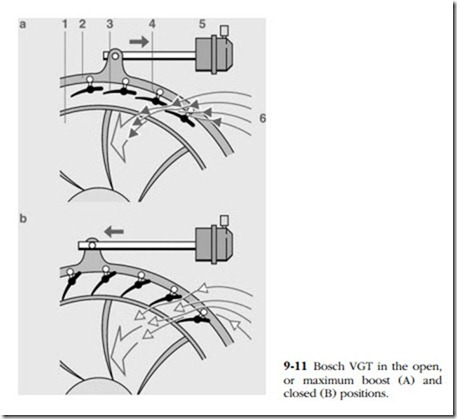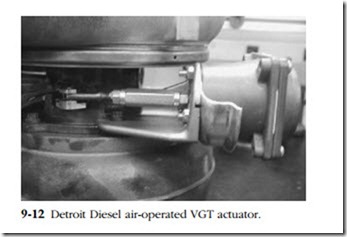Variable geometry turbine
Variable geometry turbine (VGT) turbochargers include a throttling mechanism on the exhaust inlet to generate boost at engine speeds just above idle. With boost comes torque, which results in low-rpm flexibility unmatched since the days of steam. But torque is a side-effect—VGT is an emissions-control expedient, intended to reduce NOx levels in the exhaust.
Until 2004, when EPA Tier 2 regulations went into effect, EGR was required only at high speeds, when exhaust-gas pressure exceeded manifold pressure. All that was needed was a connection between the exhaust pipe and the intake manifold, and exhaust flow would take care of itself. Under the present rules, EGR must be avail- able across the rpm band.
A conventional turbocharger, sized for maximum power output, cannot provide the low-speed boost necessary for exhaust gases to overcome manifold pressure. BMW uses two conventional turbochargers—a small unit that develops boost just off idle and a larger turbocharger for maximum power production. Other manufacturers get around the manifold-pressure problem by throttling the intake with a butterfly valve. At low speeds, the valve closes, creating a vacuum behind it. But this expedient costs power.
The VGR generates boost at all speeds. Figure 9-11 illustrates the construction of adjustable-vane type used on motor vehicles. Pivoted vanes (3), controlled by move- ment of the adjuster ring (4), surround the turbine housing. At low speeds, the vanes swing closed like a Venetian blind. This flow obstruction increases the velocity of the exhaust gases striking the turbine wheel. The vanes also direct the gas stream toward the outer edge of the wheel for improved leverage. Exhaust-gas volume and energy increase with engine speed. At high speeds, the control vanes swing open to take advantage of the energy now available. In their full-open position, control vanes also function as a boost limiter, to prevent turbocharger overspeeding.
Variable geometry turbine systems are closely monitored for boost, exhaust back-pressure, and compressor inlet and outlet temperature, so that failure generates one
or more trouble codes. European automobiles control vane pitch and turbo boost with a stepper motor. U.S. heavy truck VGTs are controlled by lube-oil or air pressure acting on a spring-loaded diaphragm. A rod transfers diaphragm movement to the turbo adjustment ring. Replacement actuators include instructions for adjustment, an operation that requires a scanner capable of cycling the unit and a precisely regulated source of pressure. Fig. 9-12 shows a Detroit Diesel air-operated VGT actuator.

